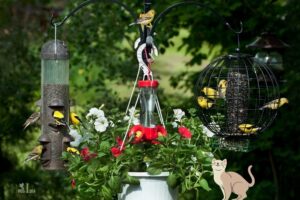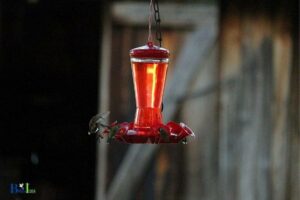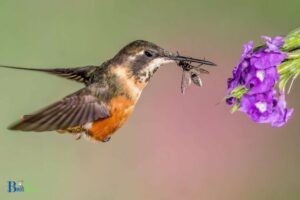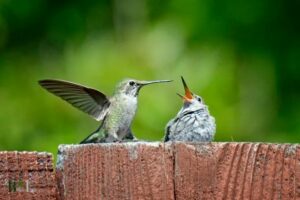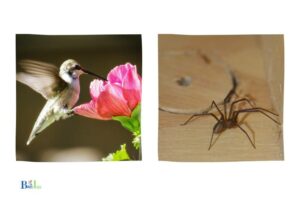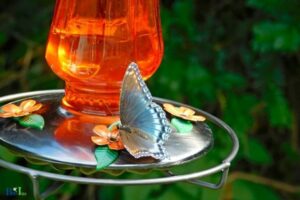How to Attract Hummingbirds in North Carolina? 10 Steps!
To attract hummingbirds in North Carolina, create an enticing garden with a variety of native flowering plants, hang hummingbird feeders filled with nectar, provide a water source, and maintain a safe, pest-free environment.
A shallow water source, like a birdbath with pebbles, can provide a place for hummingbirds to bathe and drink.
Ensuring a pest-free environment involves regularly cleaning feeders and plant areas to deter ants, bees, and other pests.
Here are four tips for attracting hummingbirds to North Carolina:
With a little effort, providing the right habitat, and proper care, attracting hummingbirds to one’s backyard in North Carolina is an achievable goal.
By nurturing a garden abundant in native flowering plants, offering nectar-filled feeders, providing a water source, and maintaining a safe, pest-free environment, you create a hummingbird haven that these
10 Steps of Attracting Hummingbirds In North Carolina
| Steps | Description |
| 1. Select Suitable Feeders | Choose feeders that are red, as hummingbirds are attracted to this color. The feeder should be easy to clean and refill. |
| 2. Make Sugar Solution | Make a sugar solution with a ratio of 1 part white sugar to 4 parts water. Do not use honey, brown sugar, or artificial sweeteners. |
| 3. Regularly Replace Solution | Change the sugar solution every 2-3 days, or more often in hot weather, to prevent fermentation and mold growth. |
| 4. Use Native Plants | Landscape your garden with native plants that attract hummingbirds. These include trumpet creeper, cardinal flower, and bee balm. |
| 5. Provide Perches | Hummingbirds like to rest on bare twigs or high-wire perches, from where they can view their food sources. |
| 6. Keep Cats Inside | Keep your cats inside, as they can be a threat to hummingbirds. |
| 7. Maintain a Water Source | Have a constant source of water. A bird bath or even a sprinkler can serve this purpose. |
| 8. Avoid Pesticides | In addition to nectar, hummingbirds eat insects and spiders, so avoid using pesticides that could kill these food sources. |
| 9. Make The Area Visible | Make your hummingbird feeding area visible from your home so you can enjoy watching them feed. |
| 10. Be Patient | Lastly, be patient. It might take some time for hummingbirds to find your garden food sources. Once they discover it, they will return frequently. |
Key Takeaway
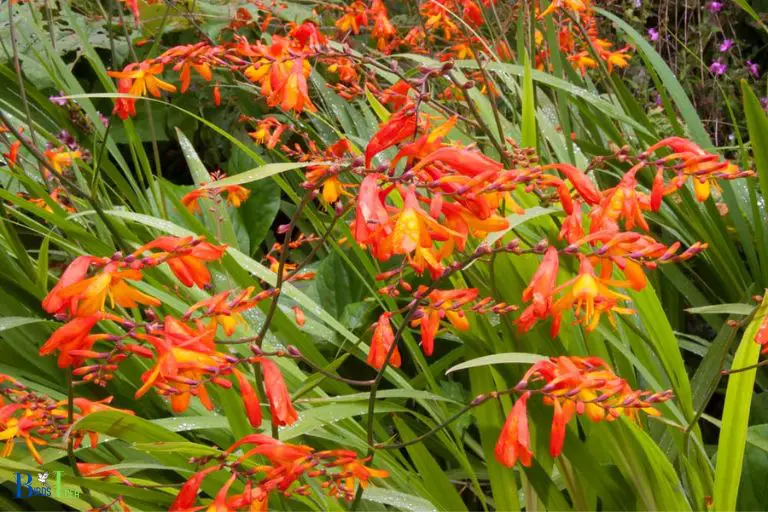
Five Facts About: Attracting Hummingbirds In North Carolina
DID YOU KNOW
According to the North Carolina Bird and Wildlife Database, there are over 30 species of hummingbirds found in the state of North Carolina.
Attracting Hummingbirds to North Carolina
Attracting hummingbirds to North Carolina is a great way to enjoy nature and brighten up your home.
Here are some tips to help you get started:

Provide a source of food:
Hummingbirds eat small insects and nectar from flowers. Planting native flowering plants or hanging a feeder filled with sugar water can help draw hummingbirds to your yard.
Provide a source of water:
Hummingbirds need to drink and bathe regularly. Consider installing a birdbath or a fountain with a shallow basin.
Offer shelter:
Hummingbirds need shelter from the wind and rain. Plant shrubs, trees, or vines around your garden to provide a safe haven for them.
Minimize pesticides:
Hummingbirds are sensitive to chemical toxins. Avoid using pesticides and chemical fertilizers in your yard.
By following these tips, you will be well on your way to attracting hummingbirds to North Carolina. With some patience and a little time, you will be able to enjoy the beauty of these delicate birds.
Why Attracting Hummingbirds to NC is Beneficial?
Hummingbirds are a natural part of North Carolina’s ecosystem and are beneficial for several reasons.
Attracting hummingbirds to the area provides several advantages for the environment and people living in the area.

Benefits of Attracting Hummingbirds to NC:
- Hummingbirds are vital to the pollination of plants and flowers, helping the environment stay healthy.
- Beneficial insects that help control pests that can damage crops are attracted to areas frequented by hummingbirds.
- Hummingbirds provide a pleasant and colorful addition to any garden or backyard, making them a great source of entertainment.
- Seeing hummingbirds in the area is a great way to connect with nature and appreciate the environment.
Attracting hummingbirds to North Carolina is beneficial for both the environment and people in the area.
By providing a hummingbird friendly environment, people can help them thrive and make sure they continue to provide their valuable contributions to the environment.
What Types of Plants and Flowers Attract Hummingbirds?
Hummingbirds are attracted to brightly colored, sweet-smelling flowers and plants. These birds prefer nectar-rich flowers with a long tube-shape.
Some of the best plants and flowers that attract hummingbirds include:

Trumpet honeysuckle: These bright red flowers are sure to attract hummingbirds.
Bee balm: This plant has bright pink and reddish-purple flowers that hummingbirds love.
Cardinal flowers: These gorgeous red flowers are sure to attract hummingbirds.
Morning glories: The tubular shape of these flowers make them the perfect nectar source for hummingbirds.
Fuchsia: These bright, eye-catching flowers are a favorite food source for hummingbirds.
Impatiens: These bright colored flowers are a great nectar source for hummingbirds.
Petunias: These bright and cheerful flowers are a great way to attract hummingbirds to your garden.
In addition to these plants, hummingbirds also enjoy tropical plants like palm and banana trees.
They also love feeders filled with sugar water. By planting these flowers and plants and providing a feeder, you can create a habitat that is sure to attract hummingbirds.
“A garden that attracts hummingbirds is a sacred realm.”
birdsidea
How to Make Hummingbird Nectar?
Hummingbird nectar is a simple solution of sugar and water that provides essential energy for hummingbirds.
Making your own nectar is easy, cost-effective and provides a safe, natural food source for your local hummingbirds.

Here are the steps to making your own hummingbird nectar:
- Mix 4 parts water with 1 part granulated sugar in a pot and bring to a boil.
- Once the mixture is boiling, remove from heat and allow to cool completely.
- Pour the mixture into a clean, sterilized container and store in a cool, dry place.
- Refill your hummingbird feeder every few days or when the mixture starts to look cloudy or discolored.
It’s important to clean your feeder regularly. This will help to reduce the risk of mold and bacterial growth in the nectar.
Use a mild soap and warm water to clean the feeder, then rinse thoroughly with clean water.
It’s important to note that hummingbirds do not need sugar water every day. They will feed on other sources of food including insects, flowers and fruit.
Making hummingbird nectar is a great way to supplement their diet and attract more hummingbirds to your yard.
Where to Place Feeders?
When setting up a bird feeder, it is important to consider the most suitable location for it.
Here are some tips for where to place your feeder:

By following these tips, you can ensure that your bird feeder is in the most suitable location and offers a safe and secure feeding environment for the birds.
Maintaining Hummingbird Feeders
Hummingbird feeders are a great way to attract the beautiful hummingbirds to your garden.
To ensure your hummingbird feeders are well-maintained, here are some tips:

Keep the feeder clean:
Use a mixture of one part white vinegar and nine parts warm water to clean the feeder at least once a week. Rinse it thoroughly and allow it to air dry before refilling.
Change the nectar regularly:
Refresh the nectar every 2-3 days during hot weather, and every 4-5 days during cooler weather.
Keep the feeder in the shade:
Also, hang it out of direct sunlight, as the nectar in direct sunlight can ferment and become toxic for the hummingbirds.
Attach a bee guard to the feeder:
This will help keep other insects away from the feeder and will also protect the hummingbirds from any potential harm.
By following these simple tips, you can easily maintain your hummingbird feeders and enjoy the beauty of hummingbirds in your garden.
Summary of Hummingbird Attraction in NC
Hummingbirds are a popular sight in North Carolina. The state has a wide variety of hummingbird species and many birdwatchers come to the state to experience them.
Hummingbirds are attracted to North Carolina for many reasons.
Some of these reasons include:

- The abundance of flowering plants in the state
- The moderate climate
- The availability of food sources such as nectar and insects
- The presence of suitable nesting and roosting sites
In addition to these natural attractions, North Carolina also provides artificial environments that attract hummingbirds. Feeders, bird baths, and other bird-friendly structures provide additional food sources, shelter, and nesting sites for these small birds.
Overall, North Carolina is a great destination for birdwatchers and hummingbird enthusiasts alike.
With its abundance of natural and artificial attractions, the state has something to offer everyone who wishes to experience the beauty of hummingbirds.
FAQ of How To Attract Hummingbirds In North Carolina
What type of food do hummingbirds like to eat in North Carolina?
Additionally, servings of over-ripe fruits like strawberries, melon and grapes are also a great snack for them.
What type of plants should I have in my garden to attract hummingbirds?
Additionally, providing flowering shrubs like weigela, azaleas, and rhododendrons will also help to attract them.
What should be considered when setting up a hummingbird feeder in North Carolina?
Additionally, ensure that the feeder is placed at least 10 feet away from anything that is potentially dangerous, such as open windows and air conditioning units.
What other habitat items should I provide to attract hummingbirds to my garden?
Additionally, it is essential to provide enough food sources and perches for the hummingbirds.
Are hummingbirds a common sight in North Carolina?
Conclusion
Attracting hummingbirds to North Carolina is attainable by planting flowers and shrubs with red or orange blooms, preparing hummingbird nectar, and keeping hummingbird feeders in the sun and clean.
All of these steps and tips can result in an enjoyable and rewarding experience for any bird lover.

